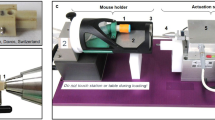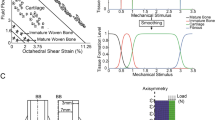Abstract
In spite of the consolidated clinical use of minimally invasive percutaneous fixation techniques, little is reported in the literature providing a mechanobiological explanation for how the design of fixation devices can affect the healing process within fractured vertebrae. The aim of this study was to develop a multi-scale mechano-regulation model capable of predicting how the patterns of tissue differentiation within a vertebral fracture change in the presence or in the absence of fixation devices and how the dimensions of the device, and the materials it is made from (Ti-6Al-4V alloy and cobalt chrome alloy) can affect the outcome of the healing process. The macro-scale model simulates the spinal segment L3-L4-L5, including the fractured body of the L4 vertebra, while the micro-scale model represents a fractured portion of cancellous bone. The macro-scale model also includes a minimally invasive percutaneous fixation device. The model predicts that fixation devices significantly shorten healing times. Increasing values of the rod diameter D and decreasing values of its radius of curvature R lead to shorter durations of the healing period. Manufacturing the rods in cobalt chrome alloy is also predicted to reduce slightly the healing period by providing greater mechanical stability within the fracture callus.








Similar content being viewed by others
References
Ament C, Hofer, EP (2000) A fuzzy logic model of fracture healing. J Biomech 33:961–918
Bailón-Plaza A, van der Meulen MCH (2001) A mathematical framework to study the effects of growth factor influences on fracture healing. J Theor Biol 212:191–209
Barbanti Brodano G, De Iure F, Cappuccio M, Palmisani M, Boriani L, Gasbarrini A, Bandiera S, Scimeca GB, Boriani S (2007) Osteosintesi con tecnica percutanea mininvasiva nel trattamento delle fratture vertebrali toraciche e lombari. Esperienza preliminare. Giornale Italiano di Ortopedia e Traumatol (GIOT) 33:78–85 (publication in Italian)
Been HD, Poolman RW, Ubags LH (2004) Clinical outcome and radiographic results after surgical treatment of post-traumatic thoracolumbar kyphosis following simple type A fractures. Eur Spine J 13:101–107
Boccaccio A, Pappalettere C, Kelly DJ (2007) The influence of expansion rates on mandibular distraction osteogenesis: a computational analysis. Ann Biomed Eng 35:1940–1960
Boccaccio A, Prendergast PJ, Pappalettere C, Kelly DJ (2008) Tissue differentiation and bone regeneration in an osteotomized mandible: a computational analysis of the latency period. Med Biol Eng Comput 46:283–298
Boccaccio A, Vena P, Gastaldi D, Franzoso G, Pietrabissa R, Pappalettere C (2008) Finite element analysis in cancellous bone failure in the vertebral body of healthy and osteoporotic subjects. Proc Inst Mech Eng H 222:1023–1036
Boccaccio A, Ballini A, Pappalettere C, Tullo D, Cantore S, Desiate A (2011) Finite element method (FEM), mechanobiology and biomimetic scaffolds in bone tissue engineering. Int J Biol Sci 7:112–132
Boccaccio A, Kelly DJ, Pappalettere C (2011) A mechano-regulation model of fracture repair in vertebral bodies. J Orthop Res 29:433–443
Carter DR, Blenman PR, Beaupré GS (1988) Correlations between mechanical stress history and tissue differentiation in initial fracture healing. J Orthop Res 6:736–748
Checa S, Prendergast PJ (2009) A mechanobiological model for tissue differentiation that includes angiogenesis: a lattice-based modeling approach. Ann Biomed Eng 37:129–145
Chow GH, Nelson BJ, Gebhard JS, Brugman JL, Brown CW, Donaldson DH (1996) Functional outcome of thoracolumbar burst fractures managed with hyperextension casting or bracing and early mobilization. Spine 21:2170–2175
Claes LE, Heigele CA, Neidlinger-Wilke C, Kaspar D, Seidl W, Margevicius KJ, Augat P (1998) Effects of mechanical factors on the fracture healing process. Clin Orthop Relat Res 355(suppl):S132–S147
Claes LE, Heigele CA (1999) Magnitudes of local stress and strain along bony surfaces predict the course and type of fracture healing. J Biomech 32:255–266
Diamond TH, Clark WA, Kumar SV (2007) Histomorphometric analysis of fracture healing cascade in acute osteoporotic vertebral body fractures. Bone 40:775–780
Geris L, Gerisch A, Sloten JV, Weiner R, Oosterwyck HV (2008) Angiogenesis in bone fracture healing: a bioregulatory model. J Theor Biol 251:137–158
Gòmez-Benito MJ, Garcìa-Aznar JM, Kuiper JH, Doblaré M (2005) Influence of fracture gap size on the pattern of long bone healing: a computational study. J Theor Biol 235:105–119
Huiskes R, van Driel WD, Prendergast PJ, Søballe K (1997) A biomechanical regulatory model of periprosthetic tissue differentiation. J Mater Sci Mater Med 8:785–788
Isaksson H, Wilson W, van Donkellaar CC, Huiskes R, Ito K (2006) Comparison of biophysical stimuli for mechano-regulation of tissue differentiation during fracture healing. J Biomech 39:1507–1516
Isaksson H, van Donkelaar CC, Huiskes R (2008) A mechano-regulatory bone-healing model incorporating cell-phenotype specific activity. J Theor Biol 252:230–246
Kelly DJ, Prendergast PJ (2005) Mechano-regulation of stem cell differentiation and tissue regeneration in osteochondral defects. J Biomech 38:1413–1422
Kim Y, Kim TW (2010) Finite element analysis of the effects of pedicle screw fixation nut loosening on lumbar interbody fusion based on the elasto-plateau plasticity of bone characteristics. Spine 35:1–8
Lacroix D, Prendergast PJ (2002) A mechano-regulation model for tissue differentiation during fracture healing: analysis of gap size and loading. J Biomech 35:1163–1171
Mizrahi J, Silve MJ, Keaveny TM, Edwards WT, Hayes WC (1993) Finite-element stress analysis of the normal and osteoporotic lumbar vertebral body. Spine 18:2088–2096
Mumford J, Weinstein JN, Spratt KF, Goel VK (1993) Thoracolumbar burst fractures. The clinical efficacy and outcome of nonoperative management. Spine 18:955–970
Nagel T, Kelly DJ (2010) Mechano-regulation of mesenchymal stem cell differentiation and collagen organisation during skeletal tissue repair. Biomech Model Mechanobiol 9:359–372
Palmisani M, Gasbarrini A, Barbanti Brodano G, De Iure F, Cappuccio M, Boriani L, Amendola L, Boriani S (2009) Minimally invasive percutaneous fixation in the treatment of thoracic and lumbar spine fractures. Eur Spine J 18:S71–S74
Pape HC, Giannoudis P, Krettek C (2002) The timing of fracture treatment in polytrauma patients: relevance of damage control orthopedic surgery. Am J Surg 183:622–629
Pauwels F (1980) A new theory concerning the influence of mechanical stimuli on the differentiation of the supporting tissues. In: Maquet P, Furlong R (eds) Biomechanics of the locomotor apparatus. Springer, Berlin, pp 375–407
Peiffer V, Gerisch A, Vandepitte D, Van Oosterwyck H, Geris L (2011) A hybrid bioregulatory model of angiogenesis during bone fracture healing. Biomech Model Mechanobiol 10:383–395
Pérez MA, Prendergast PJ (2007) Random-walk models of cell dispersal included in mechanobiological simulations of tissue differentiation. J Biomech 40:2244–2253
Sandino C, Planell JA, Lacroix D (2008) A finite element study of mechanical stimuli in scaffolds for bone tissue engineering. J Biomech 41:1005–1014
Sandino C, Checa S, Prendergast PJ, Lacroix D (2010) Simulation of angiogenesis and cell differentiation in a CaP scaffold subjected to compressive strains using a lattice modeling approach. Biomaterials 31:2446–2452
Seybold EA, Sweeney CA, Fredrickson BE, Warhold LG, Bernini PM (1999) Functional outcome of low lumbar burst fractures. A multicenter review of operative and nonoperative treatment of L3–L5. Spine 24:2154–2161
Shefelbine SJ, Augat P, Claes L, Simon U (2005) Trabecular bone fracture healing simulation with finite element analysis and fuzzy logic. J Biomech 38:2440–2450
Shen WJ, Shen YS (1999) Nonsurgical treatment of three-column thoracolumbar junction burst fractures without neurologic deficit. Spine 24:412–415
Shen WJ, Liu TJ, Shen YS (2001) Nonoperative treatment versus posterior fixation for thoracolumbar junction burst fractures without neurologic deficit. Spine 26:1038–1045
Simon U, Augat P, Utz M, Claes L (2003) Simulation of tissue development and vascularisation in the callus healing process. In: Transactions of 49th annual meeting orthopaedic research society, New Orleans
Wang ST, Ma HL, Liu CL, Yu WK, Chang MC, Chen TH (2006) Is fusion necessary for surgically treated burst fractures of the thoracolumbar and lumbar spine? A prospective, randomized study. Spine 31:2646–2652
Wood K, Buttermann G, Mehbod A, Garvey T, Jhanjee R, Sechriest V (2003) Operative compared with nonoperative treatment of a thoracolumbar burst fracture without neurological deficit. A prospective, randomized study. J Bone Jt Surg Am 85(A):773–781
Author information
Authors and Affiliations
Corresponding author
Electronic supplementary material
Below is the link to the electronic supplementary material.
Rights and permissions
About this article
Cite this article
Boccaccio, A., Kelly, D.J. & Pappalettere, C. A model of tissue differentiation and bone remodelling in fractured vertebrae treated with minimally invasive percutaneous fixation. Med Biol Eng Comput 50, 947–959 (2012). https://doi.org/10.1007/s11517-012-0937-1
Received:
Accepted:
Published:
Issue Date:
DOI: https://doi.org/10.1007/s11517-012-0937-1




